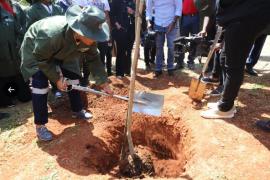
Government has planted indigenous trees at the site earmarked for the Forest of Freedom in honour of the heroes and heroines who contributed to South Africa's liberation struggle.
“By planting these trees at the Forest of Freedom, we are also honouring the 30 years of democracy and freedom,” Deputy Minister of Forestry, Fisheries and the Environment Bernice Swarts said on Sunday in Pretoria.
Addressing the launch of the Arbor Month Campaign at Freedom Park, the Deputy Minister said the infrastructure, together with the cultural and historical essence that Freedom Park symbolises, made it the most suitable venue to host the launch of the campaign.
“Freedom Park is the custodian of South Africa’s cultural and historic information. It has a wide variety of South African woodland tree species and because of its location and infrastructure it has become a home of many cultural events.
“In recent times major construction work took place to fit in a high-pressure water pipe from a reservoir situated in the Freedom Park precinct to supply the City of Tshwane with water. In the preparatory work of laying the pipe, a significant amount of land clearing and deforestation was done. In order to reclaim the disturbed area, the Forest of Freedom was conceptualised,” Swarts said.
The project involves planting and putting back some of the vegetation, including trees, that were removed in the process of clearing.
Certain key woodland species were identified to be placed in the area. The first 30 trees that were planted are dedicated to the 30 years of South Africa’s Freedom.
“The rest of other trees and shrubs will be planted to complete the Forest of Freedom. In future, key individuals will be invited to plant trees in the forest as a symbol of remembrance of their visit to Freedom Park,” she said.
Trees were also planted at other community parks within the City of Tshwane, including at Kalafong Park in Atteridgeville, Springbok Park in Hatfield, and Fountains Valley Resort in the Groenkloof Nature Reserve, south of Pretoria.
“There are reasons why we chose to plant trees at these specific parks. For instance, we chose Kalafong Park because the Kalafong community is benefiting from the park through the provision of open recreational space as well as a fitness park. Before the intervention to establish a park, the area was used as a quarry to mine soil. It was a big hole that was excavated by the housing and construction developers to mine soil and sand.
“Springbok Park is currently managed through an Adopt -A- Spot programme initiative. The initiative was established to encourage community, business organisations and other independent entities to partner with City of Tshwane in ensuring parks, open spaces and other public recreational spaces are well taken care of and beautified where possible. Thus far, the partners of the Springbok Park are doing very well,” the Deputy Minister said.
In their first year, they managed to erect a new fence and kept the park clean.
“It is important to retain the indigenous flora approach on this park to preserve its National Monument status for the coming generations because educational activities for both future generations and community.
“The Fountains Valley was chosen to showcase the restoration work that the City of Tshwane is doing at the park. Due to old age, the Celtis trees growing at the Fountains valley are dying. In the quest to preserve the Celtis trees, the City of Tshwane started on a restoration drive.
“Young Celtis trees are integrated within the existing Groenkloof Reserve and at the Fountains Valley. This is a continuous process that will take place until the diminishing Forest Celtis trees are saved,” the Deputy Minister said.
By the end of the National Arbor Month Campaign, the Department of Forestry, Fisheries and the Environment would have planted 3 500 trees at various parks within the City of Tshwane.
The tree planting activities also seek to highlight the Ten Million Trees Programme, as announced by President Cyril Ramaphosa.
“Arbor Month has found a permanent place in our events calendar as a way of celebrating and increasing awareness on the importance of trees, whilst recognising their contribution in managing deforestation and biodiversity,” the Deputy Minister said. - SAnews.gov.za


